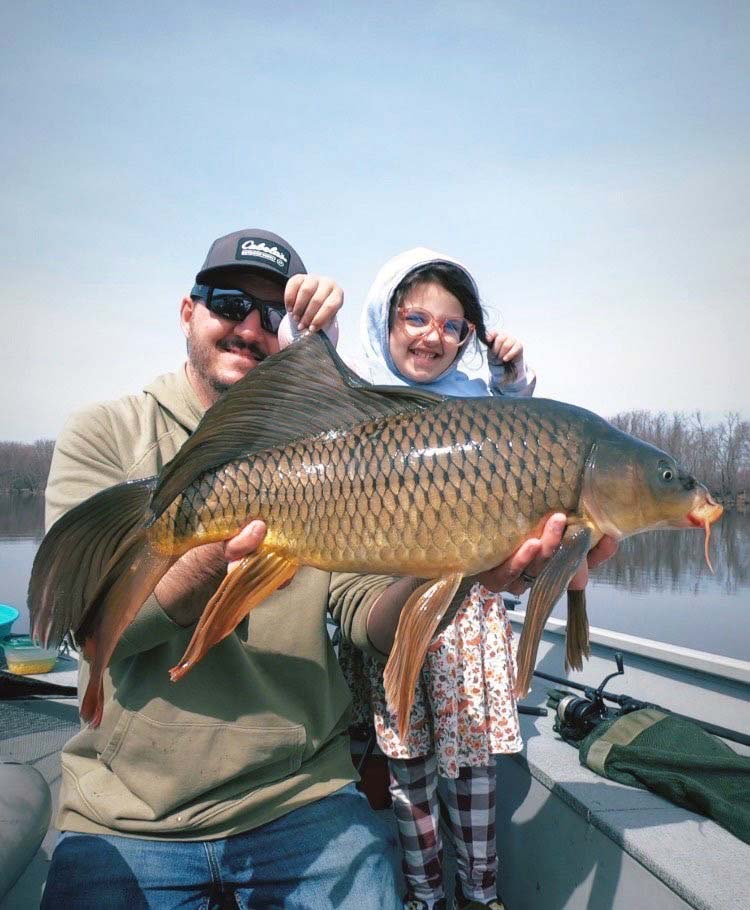
The Rodney Dangerfield of freshwater fish is beginning to get the respect it deserves.
Spring is one of the best times for carp fishing. Fish make the move into shallower and warmer waters first. Carp thrive in a little bit warmer water than some cold water species like trout. They move out of the depths from their wintering grounds and shift into more favorable areas such as shallow bays.
I like to fish smaller ponds that warm up faster than larger bodies of water in order to get on the action earlier. This I’ve noticed is where they like to sun themselves a bit while searching for food. If you find the right area, fish will stack up in shallow, warmer water. I often see them jumping and splashing as they swim around early on.
At first carp are lethargic and their eyesight is very poor as it deteriorates in cold water. Using brighter colored baits is a good idea, corn is a favorite of mine. Adding not only to the color of your bait but scent is good too. Sweet and salty are two contrasting, yet desirable scents in spring. I grew up using canned corn because it was cheap and got the job done. One can would last me all day and the carp loved it.
Baiting your area is a great way to bring in and also hold fish. Carp are usually on the move, eating and cruising on. So baiting an area will keep them around a while longer. The more you bait the more schools of fish will come through. Generally, I have found that schools of smaller fish will get pushed out by schools of larger fish the longer you bait an area. Boiling cracked corn to soften it up, mixed with other feed items such as oats and hemp seed is a common way to make carp bait. You can get crafty and use things like Jell-O, sugar and cornmeal to make a stickier substance that will make it harder for the fish to pick the bottom clean. The more you bait and keep them around, the better the action will be. Carp are cautious and also creatures of habit, often learning feeding times just like goldfish.
A popular bait for many anglers is whole kernel sweet corn. A few kernels on a hook works quite well. Another inexpensive and productive bait option for cold water carp is bread dough balls. Bait possibilities are endless and can be very simple or sometimes quite complicated when you get into the European style of carping. When it comes to baits, boilies are what most anglers use in the Euro world. Boilies are a paste/dough bait that are boiled to harden them so they hold up in the water and don’t fall off the hook. Bread balls tend to get mushy after a while and fall off your hook. The combinations of flavors and ingredients that one could use to make boilies are endless. Experimenting and making new flavors/scents is a fun part of the process.
As far as presentations there are different rigs for different baits. When fishing something like corn, a basic slider rig works well. I like to use a 12-inch leader from my hook to a barrel swivel with a glass bead or two behind it. This is followed by an egg or bank sinker. It will help you to maintain bottom contacts. It also allows the fish to take your bait without feeling any weight or resistance. Egg sinkers are useful in rocky areas. Pyramid sinkers are good for sandy areas and the bank sinker is the preferred weight of choice for most situations.
In the Euro style, hair rigs are the way to go when rigging baits. Hair rigs have extra line run past the hook and a loop is tied using a knotless knot. The loop along with a bait stopper is what will hold your bait on while the hook is left empty and exposed. When a carp comes by and vacuums up the bait, the hook goes along with it. The hooks often slip by the fish, undetected. Even if the carp spits the bait out the hook usually snags their lip. I prefer to use braided line while targeting carp. Good distance for casting, no stretch for better hooksets, and braid slices right through thick weeds. Carp have small mouths, so it makes sense that small hooks work very well to avoid spooking fish.
When you get carp in a feeding frenzy the action can be nonstop, which of course is great for keeping kids interested. There can also be variations of carp depending on where you are such as commons, mirror, grass, koi, fantail and ghost carp; you may even find a few hybrids of the aforementioned variations.
Honestly, carp are highly underrated and very often a disrespected fish. But that reputation has been changing in recent years as people view them as a gamefish now more than ever before.


